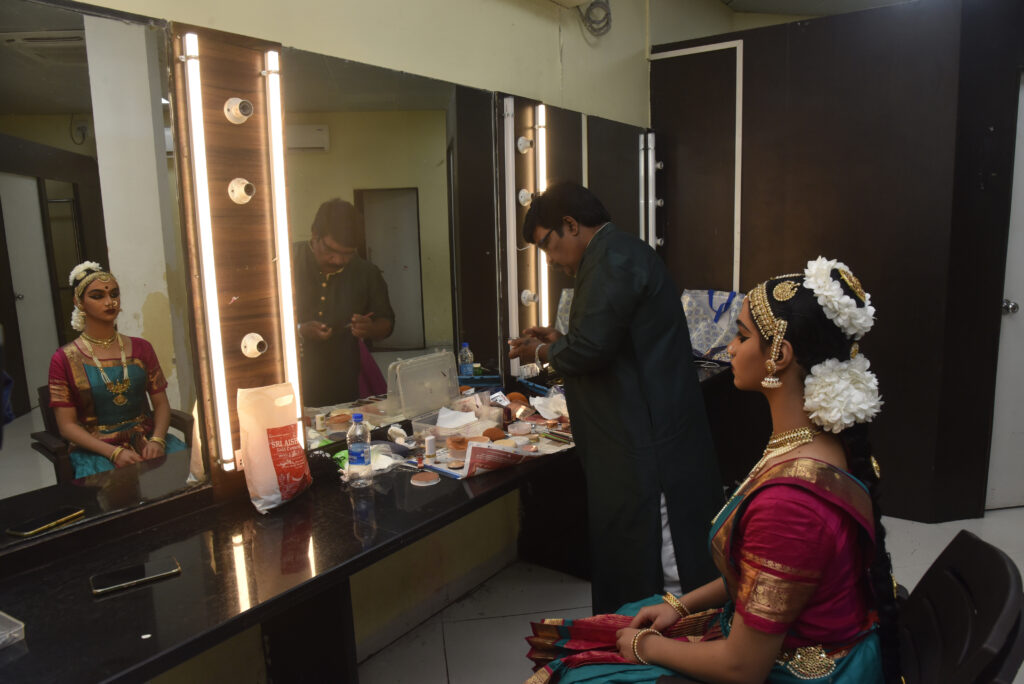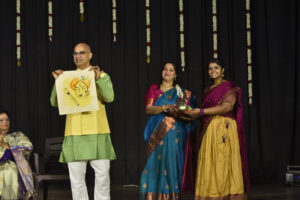An Arangetram is one of the most momentous occasions in a Bharatanatyam dancer’s life — a debut that marks years of training, devotion, and mastery of the art form. While most discussions often center around the elaborate costumes for female dancers, the attire for male dancers is equally significant and deeply rooted in cultural symbolism. Choosing the Arangetram dress for men involves a careful balance between tradition, comfort, and aesthetics.
When it comes to male dancers, two classic Indian garments stand at the forefront — the Dhoti and the Kurta. Both carry immense cultural weight and elegance, yet they serve different purposes in an Arangetram context. This blog explores the nuances of each, their historical significance, comfort, style, and how dancers can select the ideal attire that complements their performance. Additionally, it provides insights into How to wear Bharatanatyam dress, selecting Bharatanatyam Dress Colour Combination, exploring Bharatanatyam Costume online, and understanding the Arangetram dress price for male performers.
1. Understanding the Essence of Men’s Arangetram Attire
In a Bharatanatyam Arangetram, attire is not just about aesthetics—it’s a visual and spiritual extension of the dance itself. The costume mirrors the dancer’s discipline, enhances the storytelling aspect of the performance, and helps the audience connect with the rhythm and emotion of the recital.
For men, the Arangetram dress must reflect simplicity and strength, while allowing for unrestricted movement during complex postures and rhythmic sequences. The traditional outfit typically comprises a Dhoti or Veshti, often paired with an Angavastram (a draped cloth over the shoulder), and occasionally a Kurta for certain performances or formal presentations.
The choice between Dhoti and Kurta often depends on personal comfort, the style of dance being performed, and the guidance of the Guru. Both have their unique symbolism: the Dhoti represents traditional purity and discipline, while the Kurta brings in modern elegance and cultural versatility.
However, it’s important to remember that the attire must serve the art form. It should enhance the dancer’s body lines, accentuate movements, and align with the overall tone of the performance. Understanding How to wear Bharatanatyam dress correctly is crucial in maintaining both the aesthetic integrity and the comfort required for the rigorous physicality of the dance.
2. The Dhoti: A Symbol of Tradition and Grace
The Dhoti is arguably the oldest and most traditional attire for male dancers in Bharatanatyam. Originating from ancient India, it is a long piece of unstitched cloth — usually made of silk or cotton — draped around the waist and legs in a specific style that allows for freedom of movement.
In the context of a Bharatanatyam Arangetram, the Dhoti embodies simplicity, elegance, and spirituality. It connects the dancer to centuries of Indian cultural heritage and symbolizes devotion and humility. When worn properly, it highlights the rhythmic footwork and intricate leg positions that form the essence of Bharatanatyam.
The classic Dhoti for Arangetram often comes in vibrant hues — gold, white, cream, or off-white with borders of deep red, maroon, or green. These color choices align with traditional symbolism: gold for divinity, red for passion, and white for purity. The Bharatanatyam Dress Colour Combination plays a vital role in creating a visual harmony between the dancer and the stage decor.
While the Dhoti is timeless, mastering how to drape it correctly can be challenging for first-time performers. Understanding How to wear Bharatanatyam dress ensures that the fabric remains secure during rapid movements. Many dancers now opt for pre-stitched Dhotis available in the market or explore Bharatanatyam Costume online stores that offer customized fittings for performance use. These modern adaptations maintain the traditional appeal while providing ease and practicality.
The Arangetram dress price for a traditional Dhoti set varies based on fabric quality and customization. A simple cotton Dhoti might range from ₹1,000 to ₹2,000, while a pure silk version with zari borders can go up to ₹10,000 or more. Despite the cost, the Dhoti remains the gold standard for authenticity in male Bharatanatyam attire.
3. The Kurta: A Blend of Comfort and Modernity
While the Dhoti reigns supreme in traditional Arangetram attire, the Kurta has emerged as a popular alternative, especially for dancers seeking a balance between tradition and contemporary style. The Kurta, a long tunic-style garment, pairs well with churidar pants, silk pajamas, or even modern variations of the Dhoti.
The Arangetram dress for men featuring a Kurta exudes sophistication. It allows for easy dressing, offers comfort, and still captures the regal essence of Indian classical aesthetics. For performances that include fusion or thematic elements, the Kurta provides flexibility in design, color, and embellishment.
When selecting a Kurta for Arangetram, fabric plays a crucial role. Silk and raw silk are preferred for their sheen and stage presence, while cotton or linen kurtas offer breathability for extended performances. Intricate embroidery, subtle zari borders, or handwoven motifs can enhance visual appeal without distracting from the dance itself.
The Bharatanatyam Dress new models for men have introduced Kurta-Dhoti combinations that integrate traditional drapes with contemporary tailoring. These outfits ensure dancers retain full range of motion while presenting a modern aesthetic.
Kurta-based Arangetram attire also allows more experimentation with color palettes. Dancers can choose Bharatanatyam Dress Colour Combination sets such as royal blue with gold, maroon with cream, or green with copper tones to complement the stage lighting and orchestra backdrop.
The Arangetram dress price for a Kurta ensemble varies based on fabric, embroidery, and accessories. A basic cotton Kurta set can start at ₹2,000, while a custom-designed silk Kurta paired with a matching Dhoti or stole can range between ₹8,000 and ₹15,000. For those looking to buy Bharatanatyam Costume online, numerous stores now offer tailor-made options for male dancers that merge traditional silhouettes with modern cuts.
4. Choosing Between Dhoti and Kurta: A Matter of Expression
Selecting the ideal Arangetram dress ultimately depends on how the dancer wishes to express himself on stage. While the Dhoti reflects tradition, discipline, and purity, the Kurta brings refinement, comfort, and a contemporary touch.
The Dhoti allows more freedom of movement and accentuates the intricate legwork that defines Bharatanatyam dance. Its structure complements the symmetrical postures and rhythmic sequences (adavus) that demand clear visibility of foot alignment. For performances steeped in classical repertoire, the Dhoti remains the ideal choice.
The Kurta, on the other hand, offers a slightly modern approach, ideal for thematic presentations, group performances, or fusion pieces. It’s easier to manage, requires less adjustment during movement, and can be paired creatively with matching stoles or accessories to reflect the dancer’s individuality.
In both cases, attention to detail is key. The costume must fit well, enhance expression, and allow fluid transitions. The dancer should practice extensively in the chosen attire to ensure complete comfort. Many Gurus recommend that students rehearse for weeks in their full Bharatanatyam Costume online purchase before the actual performance to avoid last-minute discomfort or wardrobe issues.
Additionally, dancers should consider the following when choosing between Dhoti and Kurta:
- Fabric: Lightweight silk or cotton blends are ideal for stage lighting and ventilation.
- Colour Harmony: The Bharatanatyam Dress Colour Combination should align with the theme, lighting, and accompanying musicians’ attire.
- Cultural Authenticity: The costume must respect Bharatanatyam’s heritage and avoid overly modern interpretations that may distract from tradition.
- Budget: The Arangetram dress price should match the desired quality, durability, and craftsmanship.
Both garments, when styled thoughtfully, can make the male dancer’s Arangetram a graceful celebration of movement, heritage, and individuality.
5. The Importance of Colour and Design in Arangetram Dress
The visual impact of a Bharatanatyam Arangetram performance is greatly influenced by color selection. Every hue carries symbolic significance and affects the emotional tone of the dance. Choosing the right Bharatanatyam Dress Colour Combination can elevate the performance to a new level of artistic expression.
Traditional combinations such as red and gold, green and maroon, or blue and silver are timeless favorites, representing energy, prosperity, and devotion. Modern dancers, however, are experimenting with unique blends like teal with copper or ivory with crimson, giving a contemporary edge while preserving traditional roots.
For men, bold colors like deep maroon, mustard, navy blue, and emerald green work beautifully under stage lighting. Gold or silver zari borders highlight movements and add richness to the attire.
Modern designers offering Bharatanatyam Dress new models have introduced fusion concepts where subtle patterns, dual-tone fabrics, and textured silks redefine the traditional look. When purchasing from Bharatanatyam Costume online stores, it’s essential to check fabric quality, colorfastness, and customization options. Reliable platforms offer tailor-fit solutions ensuring the costume fits perfectly and complements the dancer’s body type.
Ultimately, the chosen Arangetram dress must reflect harmony — between the dancer, music, and divine energy the art form seeks to invoke.
6. Accessorizing the Arangetram Dress
Accessories complete the visual composition of the performance. For men, the approach is minimalist but meaningful. A traditional waistband (odiyanam), ankle bells (salangai), and a draped angavastram can enhance the look without overpowering it.
Some male dancers add a silk stole with zari detailing over the shoulder for a regal touch, especially when wearing a Kurta. When paired with the Dhoti, this accessory adds grace and symmetry. For thematic Arangetrams or fusion performances, subtle jewelry like a rudraksha mala or tilak can add authenticity to specific roles or mythological depictions.
When purchasing online, dancers can explore accessory bundles that match their Bharatanatyam Costume online order, ensuring cohesive design and ease of coordination. These curated sets often align with Bharatanatyam Dress new models, keeping up with evolving trends while maintaining traditional aesthetics.
7. Cost and Customization: Investing in an Arangetram Dress
An Arangetram is a once-in-a-lifetime milestone, and the attire deserves thoughtful investment. The Arangetram dress price depends on several factors — fabric type, design intricacy, custom fitting, and the addition of handwoven or embroidered details.
For Dhoti-based attire, expect to invest anywhere from ₹5,000 to ₹12,000 for high-quality silk with zari work. Kurta ensembles may range between ₹7,000 and ₹15,000, especially when customized with coordinated stoles or jewelry.
Many dancers now prefer sourcing their costumes from reputed Bharatanatyam Costume online stores that specialize in Arangetram wear. These platforms offer a range of Bharatanatyam Dress new models, color customization, and size fittings tailored for stage use. Some even provide virtual consultations with designers to help select the perfect Bharatanatyam Dress Colour Combination and accessories that align with the performance theme.
While the expense may seem considerable, it is an investment in art and memory. A well-chosen Arangetram dress not only enhances performance but becomes a cherished keepsake that commemorates the dancer’s years of dedication.
Conclusion
Choosing between Dhoti and Kurta for a men’s Arangetram dress is more than a matter of style — it is a reflection of artistic identity, tradition, and comfort. The Dhoti stands as a timeless symbol of purity and classical authenticity, while the Kurta represents the evolution of Indian aesthetics into the modern era.
Understanding How to wear Bharatanatyam dress, exploring Bharatanatyam Costume online, and carefully selecting Bharatanatyam Dress Colour Combination ensures that the performer not only looks regal but feels deeply connected to the spirit of Bharatanatyam. Whether embracing tradition with a silk Dhoti or experimenting with Bharatanatyam Dress new models that blend Kurta elements, the ultimate goal remains the same — to honor the art through grace, discipline, and devotion.
In the end, the Arangetram dress price fades in importance compared to the cultural richness it represents. Each stitch, hue, and fold becomes a tribute to the timeless legacy of Bharatanatyam — an art form that continues to transcend generations, uniting movement, music, and meaning in perfect rhythm.
Through the right attire, every male dancer can ascend the stage with confidence, pride, and spiritual poise — embodying the true essence of the Arangetram: a celebration of art, tradition, and soul.





